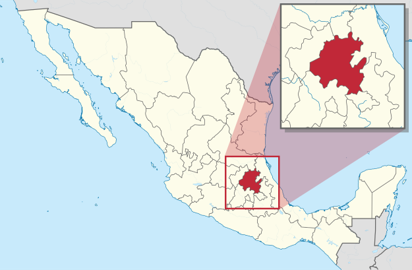Hidalgo State

Traditionally, Hidalgo's economy has been based on mining and agriculture, with manufacturing more recently. Most industry is located in what is called the “Urban Industrial Corridor of the South," where most of the state's economic activity is located. Outside of this corridor, the economy remains based on subsistence farming and has high levels of poverty, with the per capita income only 61.5% of the national average.[9] Industry accounts for more than 25% of the state's gross domestic product.
The state contains 2.1 million hectares of land, 30% of which is cultivable. Most of this land is only farmed during the annual rainy season. Corn is the primary crop followed by barley, beans, oats, wheat, green chili peppers, squash and tomatoes. Thirty-eight percent of the land is dedicated to grazing and livestock production. Fishing and fish farming are also important producing mojarra, tilapia, carp, trout and charal. Most of the surface area of the state (38%) is used for the raising of livestock with 29% dedicated to agriculture. Forests cover about 22% of the state.
Mining is the oldest and most traditional large-scale economic activity in the state. The mining of magnesium provides the most income to the state, providing 28% of all revenues, followed by zinc (18%), silver (14.3%), limestone (12.9%) and lead (7.7%). Other minerals include gold, copper, cadmium and sulfur. Most precious metals such as gold, silver and copper are mined in Pachuca and Zimapan. Petroleum, natural gas and other similar deposits also exist.
The most important commercial sector of the state is that of retail foodstuffs, especially those selling groceries, meat and poultry. This represented over 40% of the commercial sector in 1998. Just over 30% of commerce was dedicated to non-food products such as clothing and pharmaceuticals with the rest mostly dedicated to wholesale foods. From the latter 20th century, tourism has taken up much of the economic slack left behind by the demise of much of the state's mining industry, with income from this sector surpassing that of the petroleum industry. The state has a variety of historic, cultural and natural attractions. Commerce and tourism employ about 44% of the population.
Industrial production in the state centers on metal products, machinery and equipment, accounting for about 24% of the total. Non-metallic minerals, other than petroleum account for about 25%. However, the most important industry is automobile and train engine production, which is followed by the refining of petroleum products.
As the state has a relative abundance of wood, crafts based on this material is common. The most important product is the making of wood furniture, most of which is in a rustic Spanish style. Miniature boxes, flutes and other items are a speciality of a community called Nith in the Ixmiquuilpan municipality. Molango is noted for its guitars.
GDP HIDALGO $18,604 million of USD, comparable to ZIMBABWE






